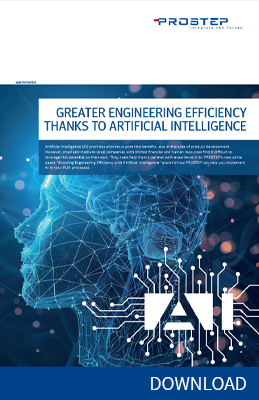 The Digital Thread is the prerequisite for the Digital Twin and business models based on it. Many use cases for the Digital Twin in engineering, production and operations can only work if traceability is guaranteed in both directions, said PROSTEP Board Member Karsten Theis at the start of the event: "This requires new integration concepts such as data linking, in addition to classic data synchronization."
The Digital Thread is the prerequisite for the Digital Twin and business models based on it. Many use cases for the Digital Twin in engineering, production and operations can only work if traceability is guaranteed in both directions, said PROSTEP Board Member Karsten Theis at the start of the event: "This requires new integration concepts such as data linking, in addition to classic data synchronization."
Various speakers demonstrated how this combination of linking and data synchronization can be realized with the help of the OpenCLM, OpenPDM and OpenDXM GlobalX software solutions, taking the Mars rover as an example. PROSTEP uses the model provided by NASA as a test environment to make abstract PLM concepts tangible.
Changes to a complex product like the Mars Rover typically involve multiple domains whose work and data are interrelated. These relationships and dependencies can be graphically modeled using the OpenCLM digital thread platform without having to replicate the information itself. The jobs defined in OpenCLM for changes to software and landing gear were then passed to the authoring systems and management tools of the respective domains via the PLM integration platform OpenPDM, together with the data for their processing.
In combination with the OpenDXM GlobalX data exchange solution, external suppliers can also be integrated into the change process. PROSTEP employees demonstrated a complete round trip from the export of CAD and metadata to the download and their processing by the supplier to the automated re-import into the client's backend systems. The completed tasks were then published back to OpenCLM to ensure their traceability and to be able to document them during audits.
The central topic of the second day of the event was PLM architecture as the basis for digital thread and digital twin and the question of how companies can achieve a PLM architecture that is fit for the future. PROSTEP's consultants use key elements of enterprise architecture management (EAM), such as the process, data and application levels, to define them. Together with the business functions, they then develop an information model that describes the information flows in the company in a system-neutral manner. This is the basis for linking the data in the IT systems of the different domains and establishing traceability.
One of the main challenges in digital product development is the growing proportion of software in products and the increasingly stringent requirements in terms of sustainability, as Martin Strietzel, Director Strategy & Processes, emphasized. New technologies and market requirements necessitate new development methods such as model-based systems engineering (MBSE). But medium-sized companies in particular are faced with the question of how much MBSE is necessary for them and how they can combine PLM and application lifecycle management (ALM). PROSTEP's Consultants help them answer such questions. How they proceed with capability-based PLM consulting was the focus of the concluding session.
Various PROSTEP customers also had their say at the PROSTEP INSIGHT DAYS, starting with printing press manufacturer KBA, which has achieved digital consistency between the PLM and ERP worlds with the help of the OpenPDM integration platform. Representatives of packaging machine manufacturer Theegarten-Pactec and the two automotive suppliers thyssenkrupp Presta and BOS told the participants in short video contributions how the consultants had supported them in selecting their PLM solutions. In addition, representatives of PLM vendors Dassault Systèmes, PTC and Siemens Digital Industries Software explained how they and their customers benefit from cooperation with PROSTEP.
Here you can watch the recordings of the PROSTEP INSIGHT DAYS.
